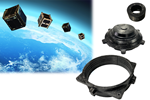U.K. academics head up flat fiber sensor research for composites
Six universities are in charge of developing flat fiber sensors, which will then be applied with industry partners, to determine their impact in monitoring composites manufacturing and more.
Wrexham University (Wrexham, Wales) is supporting a £2.2 million project which will investigate the development of making “flat” optical fiber sensors versus their circular counterparts, in an effort to make composites manufacturing more efficient and sustainable. The university is working alongside U.K.-based University of Southampton, the lead institution for the 3-year project, as well as the University of Bristol, University of Nottingham, University of Warwick and University of Herefordshire. Dr. Christopher Holmes, who is based at the Optoelectronics Research Centre (ORC) at the University of Southampton, is heading up the project.
Composites play a pivotal role in a variety of end markets. Nevertheless, understanding their behavior during the manufacturing process, as well as how they perform throughout their lifetime, has often been a challenge.
Sensors have quickly become key to providing these insights (see CW’s sensors page). Flat fiber sensors, for example, which can fit snugly inside composites, have the potential to monitor whether the material is fit for purpose and will keep its strength while it is being used. They may even be able to feed into the manufacturing process to optimize the performance of the component and predict when it is likely to fail.
“The ability to make and employ fiber optic sensors, which are capable of having directional sensing opens up huge areas of understanding in composites and beyond,” says Richard Day, professor of composites engineering and pro vice chancellor for research at Wrexham University. “For us, it is the ability to measure and control stresses in a microwave environment with a view to manufacturing large, lightweight mirrors, which is key and will enable a new direction in our research with high potential impact.”
During the span of the project, the team at ORC will develop the flat fiber sensors in their Zepler cleanrooms — a state-of-the-art multidisciplinary center for materials and device research in electronics, photonics and nanotechnology — in collaboration with manufacturing at the Bristol Composite Institute, University of Bristol. Then, researchers at Wrexham University, as well as Nottingham, Warwick and Herefordshire, will go on to use the new sensors to develop case studies, aligned with industry partners.
Wrexham University academics will also be using the facilities at the Advanced Composite Training and Development Centre, a state-of-the-art laboratory that enables such research.
“The University of Southampton has fantastic cleanroom capabilities and a strong reputation in pioneering optical fiber fabrication, and our colleagues have comprehensive knowledge of composites and their applications,” Dr. Holmes, University of Southampton, notes. “Our joint research on flat fiber sensors could transform the ultimate performance of composite structures.”
The project is being funded by the Engineering and Physical Sciences Research Council (EPSRC).
Related Content
-
Next-gen composites manufacturing: Combining material, machine and mold cavity data with analytics
Using a sensor, an edge device and machine learning software, sensXPERT sees into processes and is improving quality and cutting scrap, cycle time and energy use for composites customers like ZF and Carbon Revolution.
-
IMDEA Materials Institute helps create intelligent sensors for aviation composites
As a part of the European Union’s DOMMINIO project, IMDEA Materials Institute is helping to create embedded smart sensors via 3D printing to provide real-time updates on aircraft during flight.
-
Measuring energy use to enable sustainable composites production
Airbus subsidiary CTC uses new technology to measure energy use in machine components and processes to optimize equipment, production lines and guide decisions for future composites.












.jpg;maxWidth=300;quality=90)




